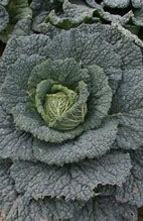
Cabbage F1 Providence
Cabbage F1 Providence,A mid-season Savoy variety, with attractive dark blue-green, deeply blistered leaves. The heads, typically 0.7-1.2Kg in weight, are round and well filled, with a short core. Good eating qualitities.
Grow your own
Difficulty – Easy
Sow - February-September
Plant out - March-October
Harvest – All year round
Seed Packet - Aprox 50 Seeds
Add depth to salads and sandwiches. A great gourmet pizza topping. Contributes delicious flavour to pasta, egg dishes and soups
Sow
Cabbages need a sunny site and firm soil. Wherever possible, prepare the soil in autumn by adding well-rotted manure or garden compost and then leave it over winter to consolidate. Before planting cabbages, make sure the soil is well firmed by shuffling along the surface on your heels, then rake it flat.
You should not grow cabbages in the same soil that you grew them (or other brassicas) the previous year.
Cabbages are best suited for growing in the open ground, but you could grow one or two in large, deep containers. They are not suitable for growing bags.
Cabbages can be either sown directly in the ground outside, or in seed trays (and left outdoors). If you only want a few cabbages, it is best to sow in seed trays, then transplant outdoors. Use modular trays, and sow one seed per module.
Traditionally, cabbages are sown into a seedbed, a site away from your main vegetable plot, then transplanted later in the season. This is because sowing cabbages at their final spacings in your main vegetable plot would take up a lot of room early in the growing season, when you could be growing fast-maturing crops, such as lettuce.
However, there is nothing stopping you sowing your cabbages into your main vegetable plot, at their final spacings, which is 30-45cm (12-18in) between plants and rows, depending on the cabbage type (check the back of the seed packet).
All the groups of cabbages are grown in exactly the same way, just the sowing times vary.
Spring cabbage: Sow in July/August; transplant in September/October.
Summer cabbage: Sow from late February/early March (under cloches or similar cover) until early May; transplant in May/June.
Winter cabbages: Sow in April/May; transplant in late June/July.
No matter if you are sowing into a seedbed, or into the final growing position, thoroughly prepare the soil by raking the surface to create a fine, crumbly texture and sow thinly at 1cm (1/2in) deep.
Grow
Transplant the young plants to their final growing position when plants have five or six true leaves, setting the lowest leaves at ground level. Water well the day before moving, firm in well after transplanting and ‘puddle’ in the plants with plenty of water (this means filling the hole with water several times before adding soil).
Plant compact varieties 30cm (1ft) apart, larger varieties up to 45cm (18in) apart. Plant spring cabbages just 10cm (4in) apart in rows 30cm (1ft) apart - thin out to 30cm (1ft) apart in late February/March.
If you puddle in your cabbages well at planting, they will need little water. In prolonged dry spells, a thorough soak every 10 days will be enough. When the heads begin to form, generous watering will greatly improve head size. Feed summer and winter cabbages with a high-nitrogen fertiliser before they get too big.
Harvesting
Cabbages are harvested by cutting through the stem just above ground level with a sharp knife. Cut a 1cm (½in) deep cross in the stump of spring and summer cabbages and you'll be rewarded with a second crop of much smaller cabbages.
